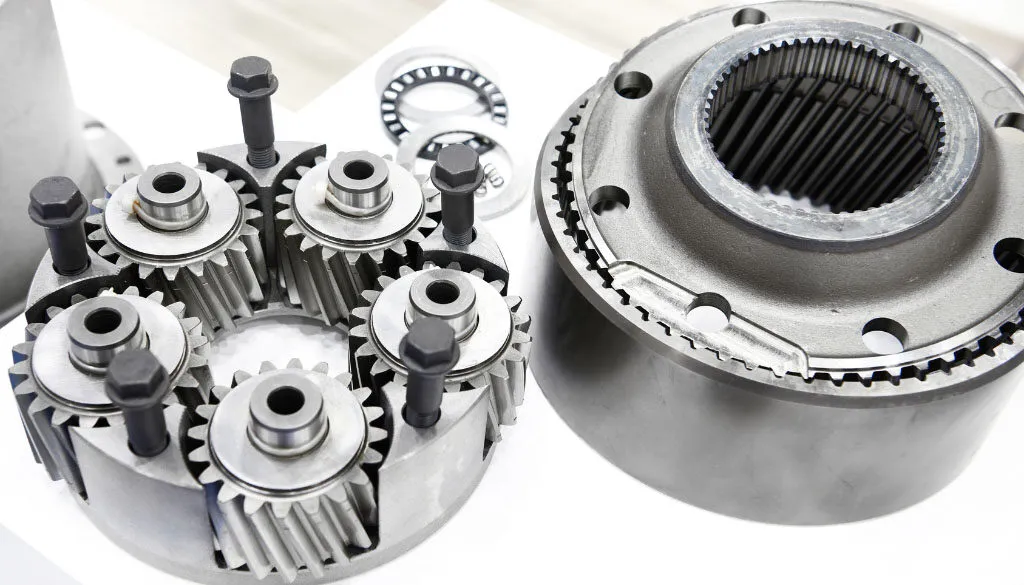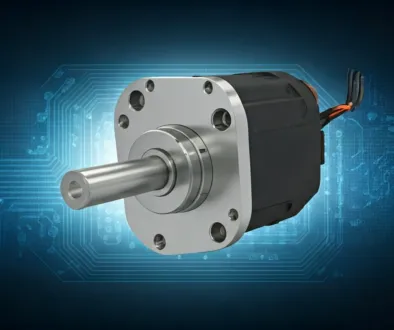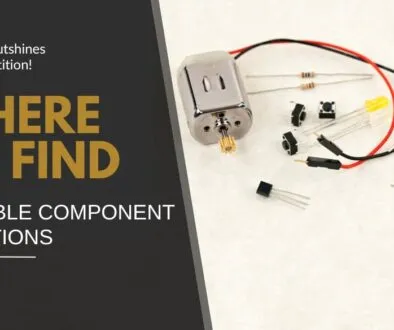What Is a Planetary Gear Motor
A planetary gear motor is a sophisticated mechanism combining a motor with a planetary gearbox to enhance torque output and precision. It features a central sun gear that drives surrounding planet gears, ensuring even load distribution and high torque capacity. The design, which reduces backlash, is compact and efficient, with customized gear stages for variable speed-to-torque ratios. This makes them ideal for industrial, automotive, and medical applications where precision and durability are essential. As you explore further, you’ll discover more about its practicality and customization options across various fields available from planetary gear motor manufacturers.
Key Takeaways
- A planetary gear motor combines a planetary gearbox with an electric motor for increased torque output.
- It features a central sun gear driving multiple planet gears, distributing the load evenly.
- The design allows for high torque output, precision control, and reduced backlash.
- Customizable gear stages enable tailored reduction ratios for specific applications.
- Planetary gear motors are ideal for industries requiring compact, durable, and efficient power transmission solutions.
Understanding Planetary Gear Motors
When you explore the workings of planetary gear motors, you’ll find a sophisticated interplay between components that achieve efficient power transmission. These motors integrate a planetary gearbox with an electric motor, utilizing motor efficiency and delivering high torque output. The gearbox features a central sun gear that drives multiple planet gears, which orbit around it. This design facilitates even load distribution, vital for sustaining the durability and reliability of the gear motor in demanding industrial applications. The gear ratio in planetary gear motors is significant. It’s determined by the number of stages within the gearbox. More stages equate to higher torque but reduced speed, making these motors exceptionally suited for scenarios requiring precision control, such as robotics and automation systems. The reduced backlash offered by the planetary arrangement guarantees enhanced position accuracy, an essential attribute in applications where precision is paramount. Advancements in technology have further refined these motors by integrating encoders, which enhance control and mechanical efficiency. This evolution has expanded their versatility, making a planetary gear motor with encoder the optimal solution in various industrial applications, where high torque and efficient power transmission are critical requirements. DC planetary gear motors are most commonly available in 12VDC and 24VDC voltages. Therefore, making planetary gear motor 12v and planetary gear motor 24vdc the most popular types around the world.
Key Components and Construction
Exploring the core construction of planetary gear motors reveals a precise arrangement of components that contribute to their efficiency and reliability. At the heart of this system is the central sun gear, which drives multiple planet gears. The sun gear is attached to the output shaft of the motor, the power generator of the entire mechanism. The electric motors can come in a variety of voltages, depending on your application requirements. The planet gears are mounted on a carrier that connects directly to the output shaft, translating rotational motion into high torque capacity while maintaining a reduced size. The entire assembly is encased within a compact housing, ensuring durability and space efficiency. Here’s a breakdown of the key components:
- Central Sun Gear: Serves as the primary driver, transmitting power to the surrounding planet gears.
- Planet Gears: Multiple gears that revolve around the sun gear, allowing even load distribution and increasing torque capacity.
- Motor: Power generator for the complete gear motor assembly.
- Carrier: The structure that holds the planet gears and connects to the output shaft, facilitating the conversion of motion.
- Compact Housing: Encases the entire gear system, providing strength, reducing noise, and protecting the internal components from external elements.
This sophisticated design not only enhances the gear motor’s performance but also offers customization through various gear stages, allowing for specific reduction ratios tailored to your application needs.
How Planetary Gear Motors Work
Understanding planetary gear motors hinges on their unique design, which efficiently combines a motor and a planetary gearbox. This integration allows for superior torque output and efficiency, making it ideal for industrial automation applications. At the core, the electric motor powers the entire mechanism. The planetary gearbox utilizes a central sun gear that drives multiple planet gears. These planet gears revolve around the sun gear, mimicking planetary motion. This arrangement guarantees that torque is transmitted effectively, with even load distribution across multiple contact points. The output shaft is connected to a rotating carrier plate, which transfers torque from the motor output shaft via the sun gear through the planet gears to the final output. By adjusting the number of gear stages, you can achieve different gear ratios. Higher stages lead to greater torque, whereas fewer stages increase speed. Here’s a breakdown of the planetary gear motor’s key components:
- Electric Motor: The electric motor create the initial torque and speed that the planetary gearbox will then optimize.
- Sun Gear: The sun gear drives the planet gears and is central to torque transmission.
- Planet Gears: The planet gears rotate around the sun gear, distributing the load evenly.
- Carrier Plate: The carrier plate transfers torque to the output shaft, facilitating smooth operation.
- Gear Stages: The gear stages determine the gear ratio, affecting both torque and speed.
- Output Shaft: The output shaft delivers mechanical power as the final output of the motor.
This design reduces backlash and wear, guaranteeing precise control and smooth operation in various applications.
Advantages of Planetary Gear Motors
Building on the operational principles of planetary gear motors, their advantages become immediately apparent in specialized applications. The unique design of these motors leverages simultaneous gear engagement, optimizing torque output and ensuring a compact form factor. This makes them indispensable for sectors like robotics and automation, where precision control is paramount. With reduced backlash, planetary gear motors enhance position accuracy, vital for tasks demanding meticulous movements. Consider these advantages:
- High Torque Output: The simultaneous engagement of multiple gears results in superior torque output, allowing for efficient operation in space-constrained environments.
- Precision Control: Reduced backlash translates to increased position accuracy, making these motors ideal for applications where precision is non-negotiable.
- Enhanced Durability: With the option to be equipped with double ball bearings, these motors offer improved radial load handling, increasing their durability and longevity, especially under demanding conditions.
- Improved Mechanical Efficiency: Continuous advancements in technology contribute to enhanced mechanical efficiency, ensuring reliable performance over extended periods.
Moreover, the customizable nature of planetary gear motors means they can be tailored to meet specific electromechanical requirements, broadening their applicability across various industries. This adaptability, combined with their inherent mechanical advantages, underscores their superiority in essential applications.
Comparing Planetary and Spur Gear Motors
When evaluating the differences between planetary and spur gear motors, it’s essential to take into account their unique mechanical architectures and operational efficiencies. Planetary gear motors utilize multiple planet gears that evenly distribute loads, resulting in superior torque capacity and efficiency. This design guarantees enhanced reliability and durability, vital for applications requiring high power density and precise control. In contrast, spur gear motors transfer load through a single contact point, limiting their torque capacity and making them less efficient, especially in high-torque scenarios. The compact design of planetary gear motors allows for higher power density, delivering significant torque in smaller dimensions. This makes them ideal for applications that demand reduced backlash and improved positional accuracy. On the other hand, spur gear motors, though generally more cost-effective, tend to require larger gear sizes to achieve comparable torque levels. They’re more suitable for low torque applications, where cost considerations are paramount. Efficiency is another key differentiator. While planetary gear motors excel in high torque, low-speed applications due to simultaneous gear engagement, spur gear motors can achieve higher torque through multiple stages. However, this often comes at the expense of efficiency and increased noise, particularly at high speeds.
Applications Across Industries
Planetary gear motors, with their superior torque capacity and high efficiency, are indispensable in various industries where precision and durability are paramount. These motors offer high torque and precise control, making them ideal for demanding applications. In industrial automation, for instance, planetary gear motors drive conveyor systems and packaging machines, ensuring efficiency through high torque at low speeds. Let’s explore the key applications across different sectors:
- Robotics: Planetary gear motors provide precise positioning and torque distribution, essential for the accurate movement of robotic arms and automated systems.
- Aerospace: These motors are critical for surface adjustments in aircraft, offering reliability and precision necessary in such high-stakes environments.
- Automotive: You’ll find planetary gear motors in power window systems and seat adjustments, where their compact size and high torque density are beneficial.
- Medical Instruments: High precision and smooth operation in sensitive equipment like blood analyzers and surgical devices rely on planetary gear motors.
- Consumer Products: For high-end electro-mechanical devices that require robust power transmission, such as battery operated power tools and home automation equipment.
Each application harnesses the unique attributes of planetary gear motors, such as their ability to deliver high torque and maintain precision, ensuring peak performance across various industries.
Choosing the Right Gear Motor
Selecting the right gear motor for your application requires careful consideration of several essential factors. You must assess the torque and speed requirements, as planetary gear motors excel in high-torque, low-speed applications. This makes them ideal when efficient load distribution is vital, leveraging their compact design for seamless integration into space-constrained environments. Consider the project’s physical constraints, as planetary gear motors offer a more elongated and slender profile than bulkier alternatives like spur gear motors. Lastly, you will want to determine your supply voltage that will be powering the gear motor. Precision in positioning is another key consideration, especially in robotics and automation, where accuracy is paramount. Planetary gear motors provide reduced backlash, ensuring precise control and reliable performance in intricate maneuvers. If your application demands exact positioning, these motors should be your primary choice. Furthermore, explore custom manufacturing options to tailor the gear motor to your specific power and size requirements. Both planetary and spur gear motors can be manufactured to meet unique specifications, ensuring superior performance in your application. By understanding these factors, you can select a gear motor that not only meets your operational needs but also enhances efficiency and reliability, ultimately contributing to the success of your project.
Frequently Asked Questions
What Is the Purpose of a Planetary Gear?
Imagine a dance where gears waltz smoothly together; that’s the magic of a planetary gear box. You alter speed and torque by changing the gear ratio between input and output shafts. The design guarantees load distribution across multiple contact points, enhancing torque capacity and compactness. You achieve efficient torque transmission, essential for precision tasks in robotics and automation. It maintains stability, reduces backlash, and integrates seamlessly into diverse mechanical systems.
What Are the Pros and Cons of Planetary Gears?
When considering planetary gears, you’ll find several pros and cons. On the plus side, they offer high torque density and efficiency due to their compact design and even load distribution. You’ll appreciate the reduced backlash for precision applications. However, they can be noisier and require more maintenance, needing proper lubrication to reduce wear. Carefully weigh these factors to determine if planetary gears meet your specific technical and operational needs.
When should I use planetary gear motors?
Planetary gear motors are ideal for applications requiring high torque and precision in a compact design. They’re commonly used in industries like robotics, medical, automotive, and industrial automation where efficient load distribution, minimal backlash, and durability are essential.
What is the working principle for planetary gear motors?
The working principle of a planetary gear motor involves a central sun gear driving multiple planet gears, which revolve around it. This arrangement, encased by an outer ring gear, allows for even load distribution and high torque output. The unique gear setup enables smooth power transmission and effective torque control.
Do planetary gear motors increase torque?
Yes, planetary gear motors are specifically designed to increase torque. The multiple gears working together allow for significant torque amplification, through speed reduction, while maintaining a compact size. This feature makes them especially suitable for high-demand applications requiring powerful and precise control.
What is the lifespan of a planetary gear motor?
The lifespan of a planetary gear motor depends on factors like operating conditions, maintenance, and load. With proper use and maintenance, these motors can have a long lifespan, often outperforming other motor types in demanding applications due to their durable design and efficient load distribution.
Why are planetary gear motors stronger?
Planetary gear motors are stronger because of their unique gear arrangement. The load is distributed across multiple contact points, reducing wear and allowing for higher torque output in a smaller space. This strength, combined with reduced backlash, makes them highly reliable and resilient in high-stress environments.
Conclusion
You’ve explored the mechanics and advantages of planetary gear motors, uncovering their intrinsic value in sophisticated applications. By opting for these compact powerhouses, you’re not just selecting a component; you’re embracing a paradigm of efficiency and precision. Their even load distribution and high torque capabilities position them as a discreet yet formidable force in modern engineering, offering a gentle nudge towards innovation. In choosing wisely, you invest in a future where performance meets finesse.





